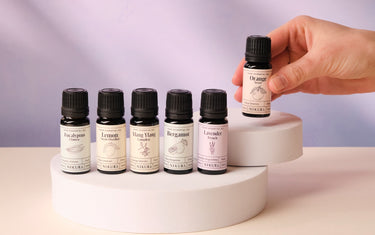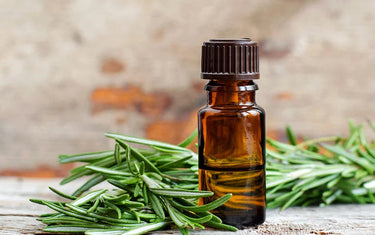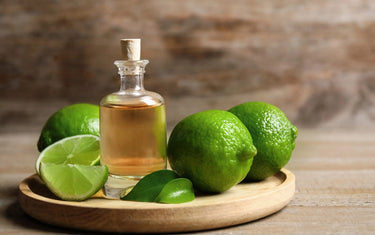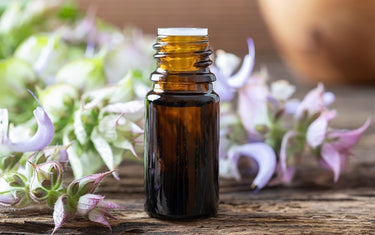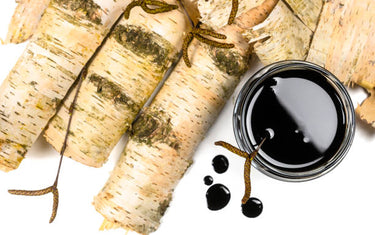8 min read / 26 March 2024 / yasmin sharp
8 Benefits and Uses of Star Anise Oil
Discover the ancient benefits of star anise oil for health and wellness, from antiviral properties to digestive relief.
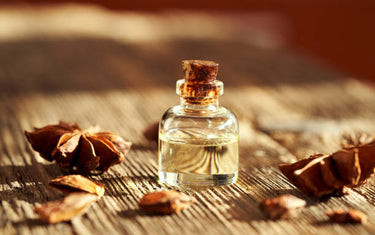
Star anise is an ancient Chinese remedy that can offer our bodies protection against certain viral, fungal and bacterial infections.
Although many people in the west recognise it first as a spice as it is prominently used in many Southeast Asian recipes, star anise is well-known in aromatherapeutic circles for its health-boosting properties.
We take a deep dive into the uses and benefits of star anise oil, to help you learn and discover more about its wellness and potential and some of the ways you can include it in your daily routine.
What is star anise essential oil?Star anise essential oil is a prominent member of the Illiciaceae family and is extracted from the dried ripe fruit of the evergreen tree via steam distillation. The tree is native to Southeast Asia, with each fruit containing 5-13 seed packets that are formed in the shape of a star, which is how the spice originally got its name. It is often confused with aniseed, as they share similar names and liquorice-like aromas, although they come from two separate plants that live in completely different parts of the world. |
How does star anise oil work?
Although star anise is used in relatively small amounts, it can still pack a punch and deliver a host of powerful health benefits.
For example, star anise contains quite a few notable bioactive compounds, all of which are recognised as offering significant contributions to our wellbeing.
It is particularly dense in polyphenols and flavonoids, which could be the main reason for the fruit’s many medicinal benefits, including its anti-inflammatory, antiviral and antimicrobial properties.
Star anise contains compounds such as gallic acid, limonene, anethole, linalool and quercetin, which have been highlighted by several studies for their health-boosting abilities.

What are the benefits of star anise oil?
The natural benefits of star anise essential oil suggest that it could be used to:
1. Help relieve some flu symptoms
The flu virus tends to last from October through to May, bringing with it a host of unwanted symptoms.
It may also explain why warm, expectorant oils, like star anise, tend to be in heavy rotation during this period too.
Shikimic acid is one of the main agents used in pharmaceuticals to give protection against and the treatment of the influenza virus, a chemical that is a key component of star anise.
In 2018, researchers found that the fruit is actually the primary source of shikimic acid in pharmaceuticals, which could make it a powerful anti-flu agent for use around the home. [1]
Other studies have also identified that star anise could prove useful against other viral infections, demonstrating a certain level of antiviral activity against a strain of the herpes virus. [2]
2. Provide protection against fungal infections
Another key component of star anise is anethole, which can also be found in aniseed and is responsible for the oil’s unique scent.
When researchers took a closer look at its potential benefits, they learned that it contains strong antifungal properties that could offer protection against fungal infections. [3]
Their report suggested that anethole may even possess the ability to restrict and stop the growth of infectious fungi.
Research conducted some years earlier also highlighted that the compound was able to inhibit the growth of pathological fungi in edible crops, which could lead to it being used for plant disease control in vegetable and fruit preservation. [4]
3. Potentially combat bacterial infections
In addition to its antifungal and antiviral properties, the benefits of star anise oil may also extend to preventing bacterial infections from attacking the body.
This claim is based on two main studies: one from 2013, which showed that E: coli could be successfully reduced by star anise, and another from 2014, which demonstrated how urinary tract infections could also be treated by the oil. [5] [6]
The results of a paper published in 2010 even suggested that drug-resistant bacteria could be affected by star anise. [16]
Treatment-resistant bacteria is a growing concern in the medical industry and where antibiotics are unable to provide solutions, natural remedies may be able to provide an alternative answer.
4. Offer relief from stress and anxiety
Star anise oil benefits also extend to an ability to work as a natural sedative, potentially helping to slow brain activity, relieve stress and also create a calmer state of mind.
This may be due to the presence of a component called nerolidol, which has demonstrated sedative effects in some animal tests. [7]
One review from 2020 also stated that several pharmacological studies have found star anise to contain sedative properties. [8]
This can make it a useful aid to use against symptoms of anxiety, offering a natural alternative to traditional medication.
5. Settle the stomach and ease digestive issues
Anise has been used as a traditional treatment for hundreds of years, with seeds often ground into powder and consumed as tea in the belief it can give comfort to a troubled stomach.
Although research is ongoing, some studies have published results that suggest star anise could have a positive effect on gastrointestinal diseases.
For example, a 2016 study examining the use of anise in traditional Persian medicine found that compared to a common treatment capsule (Colpermin) it helped to reduce irritable bowel syndrome symptoms by lowering discomfort, constipation, bloating and headaches. [9]

6. Offer antibacterial and anti-inflammatory benefits
A wide range of cosmetic products use star anise as an ingredient, including toothpastes and soaps.
It can also be found in some mouthwashes, with anethole again playing a starring role.
Although the study was limited in range, researchers did find evidence that suggests star anise could boost dental health by fighting germs. [10]
A mice study also found that star anise extract demonstrated antibacterial activity against methicillin-resistant Staphylococcus (MRSA) skin infection. [11]
Unfortunately, there are no studies that suggest it could offer the same benefits for humans, so more research is needed in this area.
7. Lower blood sugar levels
In addition to its antifungal, antibacterial and antiviral properties, there could be additional star anise oil benefits that enable it to regulate blood sugar levels.
A 2015 study found that anethole was able to control some of the main enzymes involved in carbohydrate metabolism. [12]
This could have a positive effect on glucose levels in the blood, and although more research is needed, there is a possibility the compound could be used to improve insulin sensitivity at some point in the future.
8. Boost heart health
It is believed that star anise may be able to reduce the presence of harmful free radicals, helping to lower oxidative stress and boost heart health.
Research in this area is limited, although early-stage studies have published some positive results.
For example, this animal study found that an ethanol extract of star anise helped to stabilise blood pressure, lipid levels and changes in weight in mice being fed a high-fat diet. [13]
Researchers also observed that there was a notable reduction in inflammation and lower amount of plaque build-up in the arteries.

How do you use star anise oil?
There are a host of star anise oil uses, with some of the most popular being as an:
Aromatherapy agent
If you’re a fan of the sweet and faintly spicy scent of liquorice, then diffusing star anise essential oil is an excellent choice during the colder months of the year.
Its scent can offer protection against respiratory illnesses along with any airborne bacteria.
Some people also find that diffusing the oil in their bedroom before going to bed can help them to relax and enjoy a good night’s rest.
Massage lotion
Star anise oil benefits can also be enjoyed when it is applied as a massage lotion, allowing its natural anti-inflammatory properties to calm and soothe the skin.
After diluting with a carrier oil, gently massage into affected parts of the body to increase blood flow, which can help to relieve inflammation and pain caused by digestive issues.
What is the history of star anise oil?
The history of star anise essential oil is firmly rooted in the East, with Chinese medicine practitioners promoting its benefits for around three thousand years.
It wasn’t until the 17th century that uses of star anise oil started to appear in the Western world, with Sir Thomas Cavendish being responsible for its arrival in England.
Aside from its many medicinal values, the fruit has long been used as a spice in a host of Southeast Asian culinary recipes, perhaps most famously in the five-space powder mix.
Today, the plant is grown in China, Vietnam, Japan and India and continues to be used as a natural remedy to manage and soothe a variety of minor ailments and conditions.

Star anise oil FAQs
Is it safe to ingest star anise essential oil?
Whilst the dried fruit is crushed into powder for culinary purposes, star anise essential oil should not be consumed.
This is true of all essential oils, as they are highly concentrated and not intended for consumption.
Aromatherapeutic and topical application are the safest and most beneficial ways to use star anise oil.
What are the risks of star anise oil?
Star anise essential oil is generally considered safe for most people to use, although there are precautions that should be taken to minimise any risks.
Before applying to the skin, the oil should always be diluted with a carrier oil and first-time users should also complete a patch test to identify any potential allergic reactions.
Is star anise good for menopause?
It is believed that the anise seed can mimic the effects of oestrogen, which could help to reduce symptoms of menopause. [14]
One study found that taking a 330mg anise seed capsule three times a day significantly reduced the frequency and severity of hot flushes of the participants. [15]
More research is needed, but these results indicate that anise could be used to lower menopause symptoms in women.
[1] Muhammad Bilal et al. (2018) Metabolic engineering strategies for enhanced shikimate biosynthesis: current scenario and future developments https://pubmed.ncbi.nlm.nih.gov/30014168/
[2] Akram Astani et al. (2011) Screening for Antiviral Activities of Isolated Compounds from Essential Oils https://www.ncbi.nlm.nih.gov/pmc/articles/PMC3096453/
[3] Filomena Nazzaro et al. (2017) Essential Oils and Antifungal Activity https://www.ncbi.nlm.nih.gov/pmc/articles/PMC5748643/
[4] Yongfu Huang et al. (2010) Antifungal activity of the essential oil of Illicium verum fruit and its main component trans-anethole https://pubmed.ncbi.nlm.nih.gov/21030909/
[5] Yamina Benmalek et al. (2013) Anti-microbial and anti-oxidant activities of Illicium verum, Crataegus oxyacantha ssp monogyna and Allium cepa red and white varieties https://www.ncbi.nlm.nih.gov/pmc/articles/PMC3728195/
[6] Sibanarayan Rath ett al. (2014) Monitoring in vitro antibacterial efficacy of 26 Indian spices against multidrug resistant urinary tract infecting bacteria https://www.ncbi.nlm.nih.gov/pmc/articles/PMC5481744/
[7] José Damasceno Nogueira Neto et al. (2013) Antioxidant effects of nerolidol in mice hippocampus after open field test https://pubmed.ncbi.nlm.nih.gov/23765368/
[8] Leandro Rocha et al. (2016) Development of New Antiherpetic Drugs Based on Plant Compounds https://www.sciencedirect.com/topics/agricultural-and-biological-sciences/illicium-verum
[9] Maryam Mosaffa-Jahromi et al. (2016) Efficacy and safety of enteric coated capsules of anise oil to treat irritable bowel syndrome https://pubmed.ncbi.nlm.nih.gov/27815079/
[10] Ali A Assiry et al. (2021) Crossover Analysis of the Astringent, Antimicrobial, and Anti-inflammatory Effects of Illicium verum/Star Anise in the Oral Cavity https://pubmed.ncbi.nlm.nih.gov/34195261/
[11] Mohamed A Salem et al. (2021) In vivo Antibacterial Activity of Star Anise (Illicium verum Hook.) Extract Using Murine MRSA Skin Infection Model in Relation to Its Metabolite Profile https://pubmed.ncbi.nlm.nih.gov/33442274/
[12] Bashir Ahmad Sheikh et al. (2015) Trans-anethole, a terpenoid ameliorates hyperglycemia by regulating key enzymes of carbohydrate metabolism in streptozotocin induced diabetic rats https://pubmed.ncbi.nlm.nih.gov/25708856/
[13] Sun Haeng Park et al. (2015) Protective activity ethanol extract of the fruits of Illicium verum against atherogenesis in apolipoprotein E knockout mice https://bmccomplementmedtherapies.biomedcentral.com/articles/10.1186/s12906-015-0750-0
[14] Nurhayat Tabanca et al. (2004) Estrogenic activity of isolated compounds and essential oils of Pimpinella species from Turkey, evaluated using a recombinant yeast screen https://www.ncbi.nlm.nih.gov/pubmed/15368661
[15] Fatemeh Nahidi et al. (2012) The Study on the Effects of Pimpinella anisum on Relief and Recurrence of Menopausal Hot Flashes https://pubmed.ncbi.nlm.nih.gov/24250540/
[16] Jyh-Ferng Yang et al. (2010) Chemical composition and antibacterial activities of Illicium verum against antibiotic-resistant pathogens https://pubmed.ncbi.nlm.nih.gov/20828316/

